
A set of companion videos for "the NRELians" comic book
- Subject:
- Engineering
- Environmental Science
- Science
- Material Type:
- Activity/Lab
- Audio/Video
- Provider:
- National Renewable Energy Lab
- Author:
- National Renewable Energy Lab
- Date Added:
- 11/08/2024

A set of companion videos for "the NRELians" comic book

A comic book that walks students through a series of labs
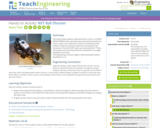
This activity helps students understand how a motor in a LEGO MINDSTORMS(TM) NXT robot uses electricity produced by the battery to move a robot to do useful work in the form of throwing a ball. Students relate the concepts of electricity and battery to the movement of the LEGO NXT motor and connected links.
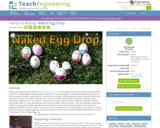
Student pairs experience the iterative engineering design process as they design, build, test and improve catching devices to prevent a "naked" egg from breaking when dropped from increasing heights. To support their design work, they learn about materials properties, energy types and conservation of energy. Acting as engineering teams, during the activity and competition they are responsible for design and construction planning within project constraints, including making engineering modifications for improvement. They carefully consider material choices to balance potentially competing requirements (such as impact-absorbing and low-cost) in the design of their prototypes. They also experience a real-world transfer of energy as the elevated egg's gravitational potential energy turns into kinetic energy as it falls and further dissipates into other forms upon impact. Pre- and post-activity assessments and a scoring rubric are provided. The activity scales up to district or regional egg drop competition scale. As an alternative to a ladder, detailed instructions are provided for creating a 10-foot-tall egg dropper rig.
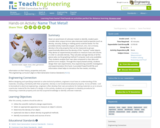
Given an assortment of unknown metals to identify, student pairs consider what unique intrinsic (aka intensive) metal properties (such as density, viscosity, boiling or melting point) could be tested. For the provided activity materials (copper, aluminum, zinc, iron or brass), density is the only property that can be measured so groups experimentally determine the density of the "mystery" metal objects. They devise an experimental procedure to measure mass and volume in order to calculate density. They calculate average density of all the pieces (also via the graphing method if computer tools area available). Then students analyze their own data compared to class data and perform error analysis. Through this inquiry-based activity, students design their own experiments, thus experiencing scientific investigation and experimentation first hand. A provided PowerPoint(TM) file and information sheet helps to introduce the five metals, including information on their history, properties and uses.
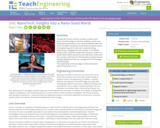
Through two lessons and four activities, students learn about nanotechnology, its extreme smallness, and its vast and growing applications in our world. Embedded within the unit is a broader introduction to the field of material science and engineering and its vital role in nanotechnology advancement. Engaging mini-lab activities on ferrofluids, quantum dots and gold nanoparticles introduce students to specific fields within nanoscience and help them understand key concepts as the basis for thinking about engineering and everyday applications that use next-generation technology nanotechnology.
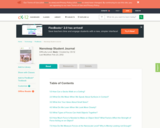
This is a Physical Science journal that supports student investgation of forces of change and nanoscale.
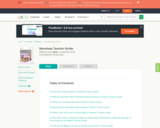
This teacher's edition provides suggestions for using the Nanoleap Student Journal in the classroom. Nanoleap is a Physical Science journal that supports student investgation of forces of change and nanoscale.
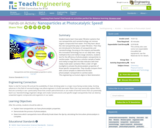
Student teams learn how water filtration systems that use nanoparticles and nanotechnology can remove organic compounds from water. First they learn about the role nanoparticles play in water filtration. Then they are introduced to the basics of nanoparticles and nanotechnology, focusing on the impacts and benefits this innovative technology has on our daily lives. Using methylene blue and methyl orange solutions, students test for the efficiency of photocatalytic nanoparticles to sanitize water. They expose a solution sample of water and methyl orange (the microbe indicator) with their newly-made water sanitation filters under UV light (sunlight) to activate the photocatalytic properties of three specific nanoparticles. They visually compare them with control samples to determine the best photocatalytic nanoparticle to sanitize water.

Learn about nanoscience from the staff at the Lab's Molecular Foundry in this Live Science event, hosted by the K-12 STEM Education office on Oct. 9, 2020
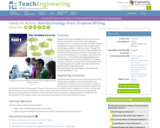
Students apply the knowledge gained from the previous lessons and activities in this unit to write draft grant proposals to the U.S. National Institutes of Health outlining their ideas for proposed research using nanoparticles to protect against, detect or treat skin cancer. Through this exercise, students demonstrate their understanding of the environmental factors that contribute to skin cancer, the science and mathematics of UV radiation, the anatomy of human skin, current medical technology applications of nanotechnology and the societal importance of funding research in this area, as well as their communication skills in presenting plans for specific nanoscale research they would conduct using nanoparticles.

These NanoSense Student Materials have been designed to help high school students understand science concepts that account for nanoscale phenomena, and the principles, applications, and implications of nanoscale science.

These NanoSense Teacher Materials been designed to help teachers help high school students understand science concepts that account for nanoscale phenomena, and the principles, applications, and implications of nanoscale science.
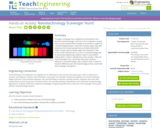
Through a scavenger hunt, students are introduced to the world of nanotechnology. In the form of a competition, groups race to locate symbols that correlate to an answer to a general nanotechnology question. Each team receives paper slips with questions; the remaining questions are hidden behind QR codes. Groups need to answer eight total questions in the correct order. Because this is an intro to nanotechnology and its associated engineering, students need to use problem-solving skills in order to identify the correct answers. After the initial scavenger hunt, a brief class discussion explores advances in nanotechnology. Next, students work in teams to research different areas of nanotechnology as they create their own scavenger hunt games.
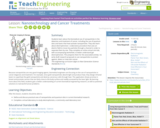
Students learn about the biomedical use of nanoparticles in the detection and treatment of cancer, including the use of quantum dots and lasers that heat-activate nanoparticles. They also learn about electrophoresis a laboratory procedure that uses an electric field to move tiny particles through a channel in order to separate them by size. They complete an online virtual mini-lab, with accompanying worksheet, to better understand gel electrophoresis. This prepares them for the associated activity to write draft research proposals to use nanoparticles to protect against, detect or treat skin cancer.

Students are given a general overview of nanotechnology principles and applications, as well as nanomaterials engineering. Beginning with an introductory presentation, they learn about the nano-scale concept and a framework for the length scales involved in nanotechnology. Engineering applications are introduced and discussed. This prepares students to conduct the associated activity in which they relate the nano-length scale to everyday objects. At completion, students are able to identify nanotechnology applications and have a frame of reference for the second lesson of the unit.

In this video adapted from NOVA scienceNOW, find out about the discovery of a new building material, the carbon nanotube, whose physical properties could theoretically enable the creation of a 22,000-mile elevator to space.
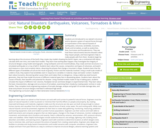
Students are introduced to our planet's structure and its dynamic system of natural forces through an examination of the natural hazards of earthquakes, volcanoes, landslides, tsunamis, floods and tornados, as well as avalanches, fires, hurricanes and thunderstorms. They see how these natural events become disasters when they impact people, and how engineers help to make people safe from them. Students begin by learning about the structure of the Earth; they create clay models showing the Earth's layers, see a continental drift demo, calculate drift over time, and make fault models. They learn how earthquakes happen; they investigate the integrity of structural designs using model seismographs. Using toothpicks and mini-marshmallows, they create and test structures in a simulated earthquake on a tray of Jell-O. Students learn about the causes, composition and types of volcanoes, and watch and measure a class mock eruption demo, observing the phases that change a mountain's shape. Students learn that the different types of landslides are all are the result of gravity, friction and the materials involved. Using a small-scale model of a debris chute, they explore how landslides start in response to variables in material, slope and water content. Students learn about tsunamis, discovering what causes them and makes them so dangerous. Using a table-top-sized tsunami generator, they test how model structures of different material types fare in devastating waves. Students learn about the causes of floods, their benefits and potential for disaster. Using riverbed models made of clay in baking pans, students simulate the impact of different river volumes, floodplain terrain and levee designs in experimental trials. They learn about the basic characteristics, damage and occurrence of tornadoes, examining them closely by creating water vortices in soda bottles. They complete mock engineering analyses of tornado damage, analyze and graph US tornado damage data, and draw and present structure designs intended to withstand high winds.
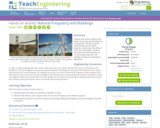
Students learn about frequency and period, particularly natural frequency using springs. They learn that the natural frequency of a system depends on two things: the stiffness and mass of the system. Students see how the natural frequency of a structure plays a big role in the building surviving an earthquake or high winds.
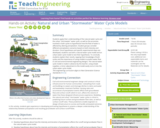
Students apply their understanding of the natural water cycle and the urban "stormwater" water cycle, as well as the processes involved in both cycles to hypothesize how the flow of water is affected by altering precipitation. Student groups consider different precipitation scenarios based on both intensity and duration. Once hypotheses and specific experimental steps are developed, students use both a natural water cycle model and an urban water cycle model to test their hypotheses. To conclude, students explain their results, tapping their knowledge of both cycles and the importance of using models to predict water flow in civil and environmental engineering designs. The natural water cycle model is made in advance by the teacher, using simple supplies; a minor adjustment to the model easily turns it into the urban water cycle model.